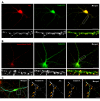Arc/Arg3.1 interacts with the endocytic machinery to regulate AMPA receptor trafficking
- PMID: 17088211
- PMCID: PMC1784006
- DOI: 10.1016/j.neuron.2006.08.033
Arc/Arg3.1 interacts with the endocytic machinery to regulate AMPA receptor trafficking
Abstract
Arc/Arg3.1 is an immediate-early gene whose mRNA is rapidly transcribed and targeted to dendrites of neurons as they engage in information processing and storage. Moreover, Arc/Arg3.1 is known to be required for durable forms of synaptic plasticity and learning. Despite these intriguing links to plasticity, Arc/Arg3.1's molecular function remains enigmatic. Here, we demonstrate that Arc/Arg3.1 protein interacts with dynamin and specific isoforms of endophilin to enhance receptor endocytosis. Arc/Arg3.1 selectively modulates trafficking of AMPA-type glutamate receptors (AMPARs) in neurons by accelerating endocytosis and reducing surface expression. The Arc/Arg3.1-endocytosis pathway appears to regulate basal AMPAR levels since Arc/Arg3.1 KO neurons exhibit markedly reduced endocytosis and increased steady-state surface levels. These findings reveal a novel molecular pathway that is regulated by Arc/Arg3.1 and likely contributes to late-phase synaptic plasticity and memory consolidation.
Figures










References
-
- Banker GA, Cowan WM. Rat hippocampal neurons in dispersed cell culture. Brain Res. 1977;126:397–342. - PubMed
-
- Barik S. Megaprimer PCR. Methods Mol Biol. 2002;192:189–196. - PubMed
-
- Blanpied TA, Scott DB, Ehlers MD. Dynamics and regulation of clathrin coats at specialized endocytic zones of dendrites and spines. Neuron. 2002;36:435–449. - PubMed
-
- Bock J, Thode C, Hannemann O, Braun K, Darlison MG. Early socio-emotional experience induces expression of the immediate-early gene Arc/arg3.1 (activity-regulated cytoskeleton-associated protein/activity-regulated gene) in learning-relevant brain regions of the newborn chick. Neuroscience. 2005;133:625–633. - PubMed
-
- Boehm J, Malinow R. AMPA receptor phosphorylation during synaptic plasticity. Biochem Soc Trans. 2005;33:1354–1356. - PubMed
Publication types
MeSH terms
Substances
Grants and funding
LinkOut - more resources
Full Text Sources
Other Literature Sources
Molecular Biology Databases
Research Materials

